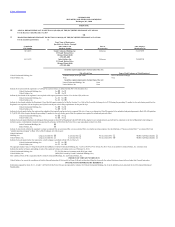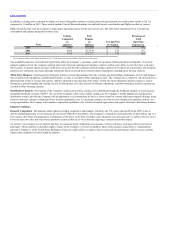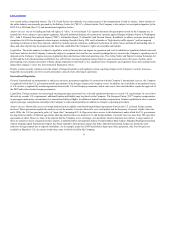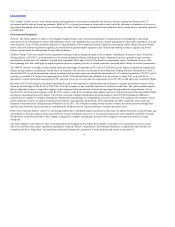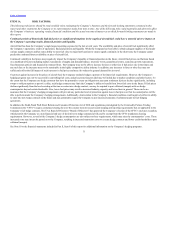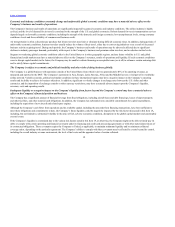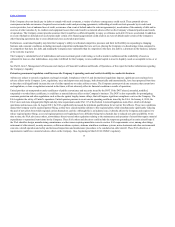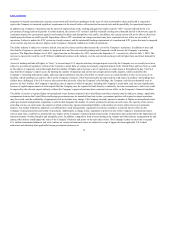United Airlines 2013 Annual Report Download - page 4
Download and view the complete annual report
Please find page 4 of the 2013 United Airlines annual report below. You can navigate through the pages in the report by either clicking on the pages listed below, or by using the keyword search tool below to find specific information within the annual report.
Table of Contents
With key global air rights in the United States, Asia-Pacific, Europe, Middle East, Africa, and Latin America, UAL has the world’s most comprehensive
global route network. UAL, through United and its regional carriers, operates an average of more than 5,300 flights a day to more than 360 airports across six
continents from the Company’s hubs at Newark Liberty International Airport (“Newark Liberty”), Chicago O’Hare International Airport (“Chicago O’Hare”),
Denver International Airport (“Denver”), George Bush Intercontinental Airport (“Houston Bush”), Hopkins International Airport (“Cleveland”), Los Angeles
International Airport (“LAX”), A.B. Won Pat International Airport (“Guam”), San Francisco International Airport (“SFO”) and Washington Dulles
International Airport (“Washington Dulles”). In February 2014, the Company announced that it would be reducing its flying from Cleveland in stages
beginning in April 2014. See Part II, Item 7, Management’s Discussion and Analysis of Financial Condition and Results of Operations, 2014 Outlook of this
report for additional information on Cleveland.
All of the Company’s domestic hubs are located in large business and population centers, contributing to a large amount of “origin and destination”
traffic. The hub and spoke system allows us to transport passengers between a large number of destinations with substantially more frequent service than if
each route were served directly. The hub system also allows us to add service to a new destination from a large number of cities using only one or a limited
number of aircraft. As discussed under below, United is a member of Star Alliance, the world’s largest airline network.
Regional. The Company has contractual relationships with various regional carriers to provide regional jet and turboprop service branded as United Express.
These regional operations are an extension of the Company’s mainline network. This regional service complements our operations by carrying traffic that
connects to our mainline service and allows flights to smaller cities that cannot be provided economically with mainline aircraft. Chautauqua Airlines,
Republic Airlines, CommutAir Airlines, ExpressJet Airlines, GoJet Airlines, Mesa Airlines, Shuttle America, SkyWest Airlines (“SkyWest”) and Trans States
Airlines (“Trans States”) are all regional carriers, which operate most of their capacity contracted to United under capacity purchase agreements (“CPAs”)
with United. Under these CPAs, the Company pays the regional carriers contractually-agreed fees (carrier-controlled costs) for operating these flights plus a
variable reimbursement (incentive payment for superior operational performance) based on agreed performance metrics. The fees for carrier-controlled costs are
based on specific rates for various operating expenses of the regional carriers, such as crew expenses, maintenance and aircraft ownership, some of which are
multiplied by specific operating statistics (e.g., block hours, departures) while others are fixed monthly amounts. Under these CPAs, the Company is
responsible for all fuel costs incurred as well as landing fees, facilities rent and other costs, which are passed through by the regional carrier to the Company
without any markup. In return, the regional carriers operate this capacity exclusively for United, on schedules determined by the Company. The Company
also determines pricing and revenue management, assumes the inventory and distribution risk for the available seats, and permits mileage accrual and
redemption for regional flights through its MileagePlus loyalty program.
While the regional carriers operating under CPAs comprise more than 95% of all regional flights, the Company also has prorate agreements with Hyannis Air
Service, Inc. (“Cape Air”), Silver Airways (“Silver”), SkyWest and Trans States. Under these commercial flying agreements, the Company and its regional
carriers agree to divide revenue collected from each passenger according to a formula, while both the Company and its regional carriers are individually
responsible for their own costs of operations. Unlike CPAs, under a prorate agreement, the regional carrier retains the control and risk of scheduling, and in
most cases, market selection, local seat pricing and inventory for its flights, although the Company and its regional carriers may coordinate schedules to
maximize connections.
Financial information on the Company’s operating revenues by geographic regions, as reported to the U.S. Department of Transportation (the “DOT”), can be
found in Note 18 to the financial statements included in Part II, Item 8 of this report.
Alliances. United has a number of strategic bilateral and multilateral alliances with other airlines, including marketing alliances and joint ventures, which
enhance travel options for customers by providing greater time of
4

